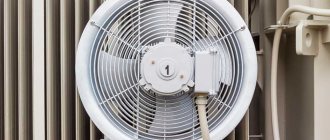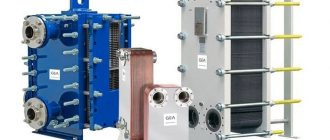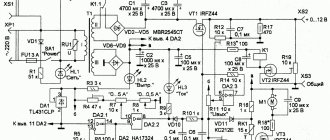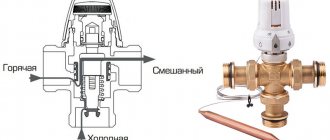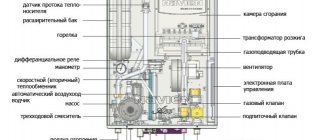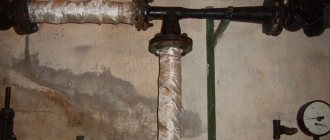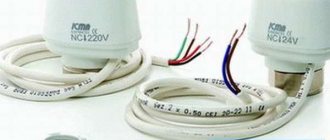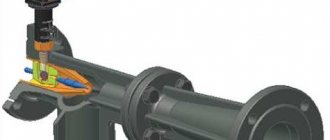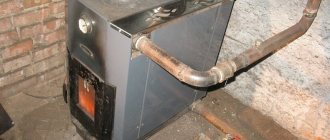A heat exchanger is a simple piece of equipment that is often included in the circuit of various types of industrial devices. In some cases, plate heat exchangers are used in domestic air conditioning and refrigeration systems. As the name implies, these devices are designed to select thermal energy from one medium and transfer it to another.
Plate heat exchanger is used for heating or cooling various processes
Design Features
The main purpose of any type of plastic heat exchanger is to convert heated liquid into a cooled environment. The design of the plate heat exchanger has collapsible parts, and the device consists of the following elements:
- set of plates;
- movable and fixed plates;
- rounded upper and lower guides;
- fastening elements that combine the slabs into a common frame.
Frame sizes of different products can vary significantly. They will depend on the heat transfer and power of the heater - with a large number of plates, the productivity of the equipment increases and, naturally, the weight and dimensions increase.
You can control the power on the heat exchanger - increase or decrease
Advantages of plate devices:
- low production and investment costs;
- highly efficient heat transfer;
- small dimensions;
- self-cleaning effect using high turbulent flow;
- the ability to increase efficiency by adding plates;
- high degree of reliability;
- ease of washing;
- small weight;
- ease of installation;
- minimal surface contamination;
- impossibility of mixing liquids due to a special seal configuration;
- high corrosion resistance;
- minimal heat transfer surface due to high efficiency;
- insignificant pressure losses due to the optimal choice of plates with different types of profiles;
- effective temperature regulation due to the small volume of coolant.
In this video you will learn how hot water is generated thanks to a heat exchanger:
Steel unit
Steel heat exchangers are the most common due to the availability of the material and ease of processing. The cost of products is low, so the price for the end buyer is the most affordable. Steel units are characterized by a long service life and ductility. The last parameter is very important due to the contact of the material with a high-temperature environment. Plasticity prevents cracks from forming in areas where the impact of the burner provokes thermal stress. Disadvantages of steel heat exchangers include susceptibility to corrosion, a common problem for metals. Its destructive effect outside and inside the structure reduces the overall service life of the unit. Another disadvantage is the large weight and dimensions, which in itself is unacceptable for many; in addition, fuel consumption increases due to the increased volume of coolant. The reason is the desire of manufacturers to ensure high inertness, for which the volume of internal space and the thickness of the walls of the unit are increased.
Plate arrangement
The design and operating principle of a plate heat exchanger will depend on the modification of the equipment, which may contain a different number of plates with fixed gaskets. These gaskets block the channels with the passing coolant. To achieve the required tightness of the fit of pairs of interconnected gaskets, it is sufficient to fasten these plates with a movable plate.
The loads that act on this device are distributed, as a rule, onto the plates and seals. The frame and fastening elements, by and large, constitute the body of the equipment.
The relief surface of the plates during compression guarantees a strong fastening and allows the entire heat exchanger system to gain the necessary strength and rigidity.
The gaskets are fixed to the plates using a clip connection. It must be said that the gaskets are self-centered relative to their axis during clamping. Leakage of the thermal fluid is prevented thanks to the edging of the cuff, which additionally creates a barrier.
For the installation of a plate heat exchanger, several types of seals are manufactured: with hard and soft corrugation.
More information about heat exchange equipment:
In soft plates, the channels are at an angle of 30 degrees. This type of device is characterized by high thermal conductivity, but low resistance to coolant pressure.
In rigid elements, when making grooves, an angle of 60 degrees is made. These devices are not characterized by increased thermal conductivity; their main advantage is the ability to withstand significant coolant pressure.
To achieve the best thermal efficiency, you can combine plates. Moreover, it must be taken into account that for optimal operation of the device, it is necessary that it operate in turbulence mode - the coolant must move through the channels without any delays. By the way, a shell-and-tube heat exchanger, where the design has a “pipe-in-pipe” design, has a laminar coolant flow.
What is the advantage? While maintaining the same thermal characteristics, plate equipment has significantly smaller dimensions.
Maintenance Recommendations
An inspection schedule is drawn up to monitor the condition of the plate heat exchanger. The absence of leaks and the tightness of the circuits are checked daily. Pressure and temperature readings can be taken by automatic operators (dispatching) or by a responsible person. The first increases the reliability of the entire system and reduces the likelihood of errors.
Planned maintenance of components - visual inspection, monitoring the condition of fittings, assessing functionality. Medium repairs include replacement of fittings and restoration of anti-corrosion coating. During a major overhaul, a complete disassembly of the heat exchanger is performed, identifying defective plates and seals.
Assembly and startup of a gasketed plate heat exchanger must be carried out in accordance with technical regulations. It is important to monitor the current indicators and compare them with the passport ones. Additionally, acceptable discrepancies are taken into account.
Requirements for gaskets
Devices with plates are subject to rather stringent requirements regarding the tightness of the equipment; it is for this reason that today gaskets have begun to be made from polymers. For example, ethylene propylene can easily be used at elevated temperatures - both steam and liquid. However, it begins to deteriorate quite quickly in an environment that contains large amounts of fats and acids.
Heat exchangers differ in the number of plates
The seals are attached to the plates most often using clip locks, and in rare cases - using an adhesive.
Basic washing methods
We should start with the fact that the heat exchanger is, first of all, a pipe system with liquid moving inside. But the water used in the systems is usually not of high quality. Various metal salts present in it settle on the walls of the structure, become scale and narrow the passage. There are three ways to deal with scale:
- mechanical;
- chemical;
- by pumping liquid into the system under strong pressure.
The article only discusses cleaning with your own hands, and therefore we will not talk about the third method. You definitely can’t handle it alone, since you will need a special compressor capable of creating a pressure of about 10 atmospheres. Only with the help of this device can deposits on iron surfaces be broken down.
Note! The other two methods can be handled with your own hands. Let’s say right away that this is quite difficult, and the appropriate skills will be required.
Video - Cleaning heat exchangers
https://youtube.com/watch?v=Ljjkd_IrQQg
Method number 1. Mechanical flushing
If this flushing of the gas boiler heat exchanger is used, do not forget that the exchanger itself takes up a lot of space in the heat generator. It is located above the combustion chamber, so it is not easy to get there. The algorithm of actions should be as follows.
Step one. The upper part of the housing is removed. To do this, you must turn off the electrical power and gas supply (if all this is provided for by the boiler design).
Step two. The exchanger is disconnected from the heating main.
Step three. The fixtures of the device are removed.
After this, you can remove the heat exchanger from the heat generator and proceed directly to the washing procedure. What can you see after dismantling? As a rule, all internal cavities are clogged with scale - metal salts, calcium or sodium, as well as trivalent ferum.
For cleaning you will have to use metal tools - pins, scrapers, etc.
During work, special care should be taken so as not to damage the surfaces of the structure.
In some cases, the device is wetted in a container filled with a weak solution of hydrochloric acid. And as soon as the scale softens, you can begin to remove it. At the end of the procedure, all internal voids are washed with water under low pressure. For these purposes, you can attach a hose connected to the water supply system.
You can see for yourself how much dirt will spill out. You need to wait until clean water starts flowing. Additionally, you can tap the surfaces of the device with a mallet (this is a special hammer made of wood or rubber).
Complete instructions for flushing a gas boiler
Previously, we talked about how to completely rinse and clean a gas boiler with your own hands, we advise you to read this information
Method number 2. Chemical washing
Let us immediately make a reservation that such washing is a rather complicated procedure. During the work you will need a special device called a booster. And, despite the fact that this option is extremely simplified, to implement it you should still be aware of a number of important nuances.
What is the simplification of the technique? First of all, there is no need to remove the heat exchanger and dismantle some elements of the gas boiler. You just need to disconnect a couple of pipes (a special hose needs to be connected to one of them, through which the cleaning agent will be supplied inside the housing). Having passed through the body, the product will come out through the second pipe, to which a hose will also be connected. Consequently, both in the exchanger and in the booster, the funds will move in a circle.
Now let’s look at what components the booster itself consists of. These include:
- chemical container;
- an electric heater (not all models have it, but people with experience advise purchasing just such models; this way the reagent will heat up, and being warm, it removes salt and dirt deposits more quickly and efficiently);
- pump.
Note! Such chemical reagents can be various kinds of solutions that are freely available on the domestic market. And the question of choosing the right reagent is the most pressing
In each specific case, it is necessary to take into account not only the degree of clogging, but also its type, as well as the material used in the manufacture of the heat exchanger.
Next, we will find out by what means the heat exchanger of a gas boiler can be flushed.
Stove with heat exchanger for a bath
Previously, we talked about how to choose a good stove with a heat exchanger for a bath, we advise you to read this information
Principle of operation
If we consider how a plate heat exchanger works, its operating principle cannot be called very simple. The plates are turned to each other at an angle of 180 degrees. Most often, one package contains two pairs of plates, which create 2 collector circuits: inlet and outlet of the coolant. Moreover, it must be taken into account that the steam located at the edge is not involved during heat exchange.
Today, several different types of heat exchangers are manufactured, which, depending on the operating mechanism and design, are divided into:
- two-way;
- multi-circuit;
- single-circuit.
The operating principle of a single-circuit device is as follows. The coolant circulates in the device throughout the entire circuit permanently in one direction. In addition, a counterflow of heat carriers is also produced.
Multi-circuit devices are used only when there is a slight difference between the temperature of the return and incoming coolant. In this case, the water moves in different directions.
More details about plate heat exchanger:
Two-way devices have two independent circuits. With the condition of constant adjustment of the heat supply, the use of these devices is most appropriate.
What is the difference between solid fuel boilers
In addition to burning various types of solid fuel, heat generators have a number of differences from other heat sources. These features should be taken for granted and always taken into account when connecting a solid fuel boiler to a water heating system. What are they:
- High inertia. At the moment, there are no ways to quickly extinguish a solid fuel fire in a combustion chamber.
- Formation of condensation in the firebox during heating. The peculiarity is manifested due to the flow of coolant with a low temperature (below 50 ° C) into the boiler tank.
Diagram of the design of a direct combustion TT boiler with forced air injection.
Inertia creates the danger of overheating the water jacket of the heater, as a result of which the coolant in it boils. Steam is generated, which creates high pressure, rupturing the body of the unit and part of the supply pipeline. As a result, there is a lot of water in the furnace room, a lot of steam and a solid fuel boiler unsuitable for further use.
A similar situation can arise when the heat generator piping is done incorrectly. After all, in fact, the normal operating mode of wood-burning boilers is maximum; it is at this time that the unit reaches its rated efficiency. When the thermostat reacts to the coolant reaching a temperature of 85 °C and closes the air damper, combustion and smoldering in the firebox still continues. The water temperature rises another 2-4 °C, or even more, before its growth stops.
Another unpleasant feature of the unit operating on wood is the appearance of condensation on the inner walls of the firebox due to the passage of not yet heated coolant through the water jacket. This condensate is not God’s dew at all, since it is an aggressive liquid that quickly corrodes the steel walls of the combustion chamber. Then, having mixed with the ash, the condensate turns into a sticky substance that is not so easy to tear off from the surface. The problem is solved by installing a mixing unit in the piping circuit of a solid fuel boiler.
This coating serves as a heat insulator and reduces the efficiency of a solid fuel boiler.
It is too early to breathe a sigh of relief for owners of heat generators with cast iron heat exchangers that are not afraid of corrosion. Another misfortune may await them - the possibility of destruction of cast iron from temperature shock. Imagine that in a private house the electricity was turned off for 20-30 minutes and the circulation pump driving water through the solid fuel boiler stopped. During this time, the water in the radiators has time to cool down, and in the heat exchanger it has time to heat up (due to the same inertia).
Electricity appears, the pump turns on and directs the cooled coolant from the closed heating system into the heated boiler. Due to a sharp temperature change, the heat exchanger experiences a temperature shock, the cast iron section cracks, and water runs onto the floor. It is very difficult to repair; it is not always possible to replace a section. So even in this situation, the mixing unit will prevent an accident, which will be discussed below.
Emergency situations and their consequences are described not with the aim of scaring users of solid fuel boilers or encouraging them to purchase unnecessary elements of piping schemes. The description is based on practical experience, which must always be taken into account. If the heating unit is connected correctly, the likelihood of such consequences is extremely low, almost the same as with heat generators using other types of fuel.
Area of use
Today there are several types of heat exchangers.
Moreover, each of the devices has a unique design and operating feature:
- soldered;
- collapsible;
- semi-welded;
- welded
Devices with a collapsible system are often used in heating networks that are connected to residential buildings and buildings for various purposes, in climate systems and refrigerators, swimming pools, heating stations and hot water supply circuits. Soldered devices have found their purpose in freezing units, ventilation networks, air conditioning devices, industrial equipment for various purposes, and compressors.
Detailed design of a plate heat exchanger
Semi-welded and welded heat exchangers are used in:
- ventilation and climate systems;
- pharmaceutical and chemical field;
- circulation pumps;
- food sector;
- recovery systems;
- devices for cooling devices for various purposes;
- in heating circuits and DHW.
The most popular type of heat exchanger, which is used in everyday life, is soldered, which provides heating or cooling of the coolant.
Types of heat exchangers for hot water systems
Let's look at a few examples of circuits. Gaskets can be either steel or rubber. Very easy to implement and relatively inexpensive. Significant disadvantage: the high cost is twice that of a parallel circuit. Thanks to this, they are distinguished by compact sizes, which do not in any way affect their usefulness and performance.
As in the case of parallel, it requires the mandatory installation of a temperature regulator, and is most often used when connecting public buildings. The connection of plate heat exchangers can be carried out in accordance with three main schemes: parallel, two-stage mixed, two-stage sequential. The main advantage and plus of working with collapsible structures is that they can be modified, modernized and improved, from removing unnecessary ones or adding new plates. Conclusion As practice shows, a modern plate heat exchanger is still slightly inferior to the old shell-and-tube heat exchanger according to one criterion.
In ITP Dependent heating connection with automatic regulation of heat consumption.
It is also worth servicing the PHE on time and carrying out systematic cleaning with your own hands. This scheme is the easiest to implement, but for sufficient heating it is necessary that the coolant moves actively.
The operating principle of a two-stage sequential circuit: the incoming flow is divided into two branches. Collapsible, that is, consisting of several individual tiles. DHW through a plate heat exchanger What did cleaning with citric acid lead to? The best recipes
See also: Energy passport
Characteristics and calculation
Plates and seals as the main parts of heat exchange devices are made from materials that differ in their performance and characteristics. When choosing a particular product, the main role is played by its purpose and scope of application.
If we consider heating systems and hot water supply, then in this area, plates that are made of stainless steel and plastic seals made of special rubber NBR or EPDM are most often used. The presence of stainless steel plates makes it possible to work with a coolant heated to 120 degrees; in another case, the heat exchanger can heat the liquid up to 180°C.
Gaskets are located between the plates for sealing
When using heat exchangers in the industrial sector and connecting them to technological processes exposed to oils, acids, fats, alkalis and other aggressive media, plates made of titanium, bronze and other metals are used. In these cases, the installation of asbestos or fluorine rubber gaskets is required.
The choice of heat exchanger is carried out taking into account calculations that are made using special software.
During calculations it is necessary to take into account:
- consumption of heated liquid;
- initial temperature of the coolant;
- heating fluid costs;
- required heating temperature.
The heating medium that flows through the heat exchanger can be heated water to a temperature of 90-120°C or steam with a temperature of up to 170°C. The type of coolant is selected taking into account the type of boiler equipment used. The dimensions and number of plates are selected so as to produce a coolant with a temperature that complies with current standards - no higher than 65°C.
The heat exchanger can be made of different types of metal
It must be said that the main technical characteristics, which are also considered the main advantages, are the compact dimensions of the equipment and the ability to provide a fairly significant flow rate.
The range of exchange areas and probable costs for the devices is quite high. The smallest of them, for example, from Alfa Laval, have a surface size of up to 1 m² and at the same time provide the passage of a coolant amount of up to 0.3 m³/hour. The largest devices have a size of about 2500 m² and a flow rate that exceeds 4000 m³/hour.
Connection diagrams
A heat exchanger operating on the water-to-water principle has several different connection schemes, however, the primary type circuits are mounted to the distribution pipes of the heating network (it can be private or implemented by city services), and the secondary type circuits are mounted to the water supply pipeline.
Most often, it depends only on design decisions what type of connection is allowed to be used. Also, the installation diagram and its choice are based on the standards of “Design of Heating Stations” and in the SP standard under number 41-101-95. If the ratio and difference of the maximum possible water heat flow for hot water supply to the heat flow for heating is determined in the range from ≤0.2 to ≥1, then the basis is a connection diagram in one stage, and if from 0.2≤ to ≤1, then from two degrees .
Standard
The simplest and most cost-effective scheme to implement is parallel. With this scheme, heat exchangers are mounted in series with respect to the control valve, that is, the shut-off valve, and also in parallel with the entire heating network. In order to achieve maximum heat exchange within the system, high heat carrier flow rates are required.
Two-stage scheme
Two-stage mixed system
If you use a two-stage scheme, then water is heated either in a pair of independent devices or in a monoblock installation. It is important to remember that the installation scheme and its complexity will depend on the overall network configuration. On the other hand, with a two-stage design, the efficiency level of the entire system increases and the consumption of coolants decreases (by about 40 percent).
With this scheme, water preparation occurs in two steps. The first step uses thermal energy to heat the water to 40 degrees, and the second step heats the water to 60 degrees.
Serial connection
Two-stage sequential circuit
This circuit is implemented within one of the devices for DHW heat exchange, and this type of heat exchanger is much more complex in design when compared with standard circuits. It will also cost much more.
